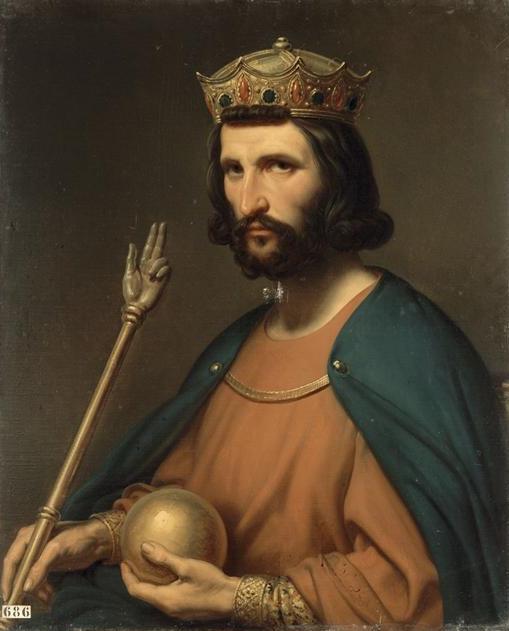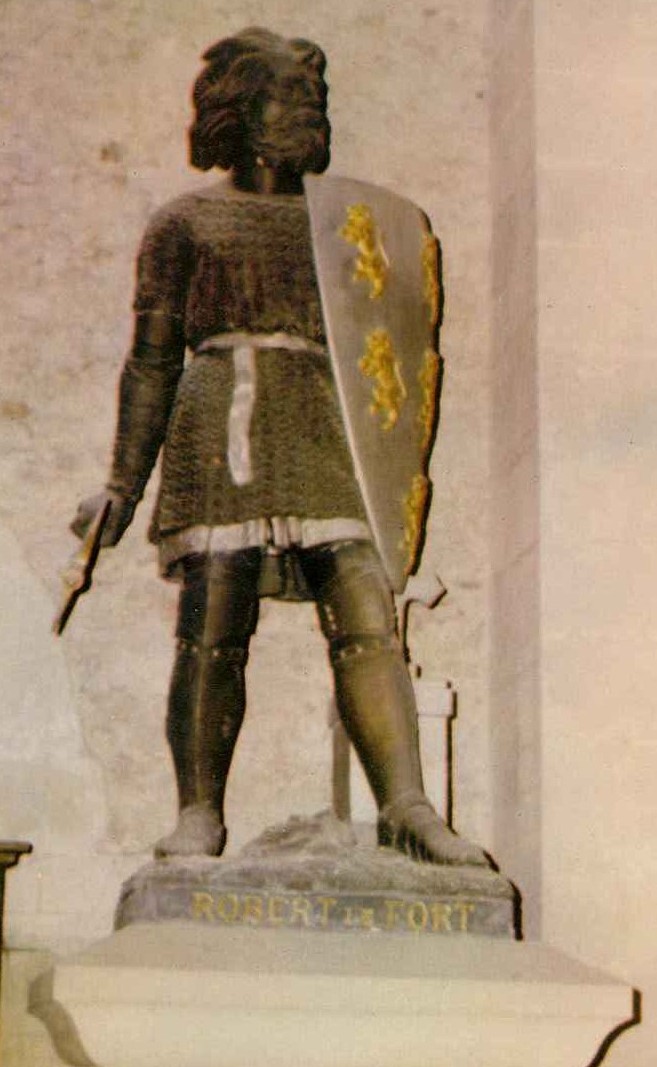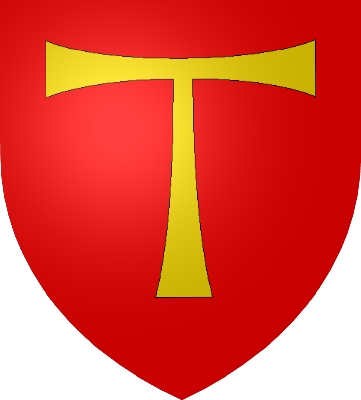|
Salomon, King Of Brittany
Salomon ( br, Salaün) (died 874) was Count of Rennes and Nantes from 852 and Duke of Brittany from 857 until his death by assassination. He used the title King of Brittany intermittently after 868. In 867, he was granted the counties of Avranches and Coutances. In popular tradition within Brittany he was canonised as "Saint Salomon" after his death and raised to the rank of martyr. Rise under Erispoe Salomon was the son of Riwallon III of Poher. In 851, Charles the Bald, after his defeat at the Battle of Jengland, made peace with Erispoe, the Breton duke, and granted him the counties of Rennes and Nantes and the Pays de Retz in Poitou as far as the river Mayenne. In 852, Salomon swore an oath to Charles and became his loyal follower (''fidelis''); in return, in a manner similar to Erispoe, he was granted Rennes, Nantes, and Retz as a "third" of Brittany to be held from Charles in fee. He and Erispoe were the ''dominatores'' of Rennes in 853. Salomon was the most powerful arist ... [...More Info...] [...Related Items...] OR: [Wikipedia] [Google] [Baidu] |
Count Of Rennes
The Count of Rennes was originally the ruler of the Romano-Frankish '' civitas'' of Rennes. From the middle of the ninth century these counts were Bretons with close ties to the Duchy of Brittany, which they often vied to rule. From 990 the Counts of Rennes were usually Dukes of Brittany. In 1203 the county was integrated into the ducal demesne. The Count of Rennes was a title held by the House of Rennes. *???–876 Gurwant, also Duke from 874 *876–888 Judicael *888–896 Berengar II of Neustria *896–903 ''unknown'' *903–953 Judicael Berengar *958–992 Conan I ''the Crooked'', also Duke from 990 *992–1008 Geoffrey I, also Duke *1008–1040 Alan I, also Duke; granted the Countship of Penthievre to his brother Eudes, thereby founding the Cadet Branch of the House of Rennes. Ruled with Odo, Count of Penthièvre until 1035. *1040–1066 Conan II, also Duke *1066–1082 Geoffrey II ''Grenonat'' *1066–1072 Hawise (in op ... [...More Info...] [...Related Items...] OR: [Wikipedia] [Google] [Baidu] |
Louis The Stammerer
Louis II, known as Louis the Stammerer (french: Louis le Bègue; 1 November 846 – 10 April 879), was the king of Aquitaine and later the king of West Francia. He was the eldest son of Emperor Charles the Bald and Ermentrude of Orléans. Louis the Stammerer was physically weak and outlived his father by a year and a half. He succeeded his younger brother Charles the Child as the ruler of Aquitaine in 866 and his father in West Francia in 877, but he was never crowned emperor. Louis was crowned king on 8 October 877 by Hincmar, archbishop of Reims, at Compiegne and was crowned a second time in August 878 by Pope John VIII at Troyes while the pope was attending a council there. The pope may have even offered him the imperial crown, but it was declined. Louis had relatively little impact on politics. He was described "a simple and sweet man, a lover of peace, justice, and religion". In 878, he gave the counties of Barcelona, Girona, and Besalú to Wilfred the Hairy. His fina ... [...More Info...] [...Related Items...] OR: [Wikipedia] [Google] [Baidu] |
Lay Abbacy
Lay abbot ( la, abbatocomes, abbas laicus, abbas miles, ) is a name used to designate a layman on whom a king or someone in authority bestowed an abbey as a reward for services rendered; he had charge of the estate belonging to it, and was entitled to part of the income. The custom existed principally in the Frankish Empire from the eighth century until the ecclesiastical reforms of the eleventh. Background Numerous synods held in France in the sixth and seventh centuries passed decrees against this abuse of church property. The Merovingians had bestowed church lands on laymen, or at least allowed them their possession and use, though not ownership.Kirsch, Johann Peter. "Lay Abbot." The Catholic Encyclopedia Vol. 9. New York: Robert Appleton Company, 1910. 26 Jul. 2015 The Merovingian kings were ... [...More Info...] [...Related Items...] OR: [Wikipedia] [Google] [Baidu] |
County Of Anjou
The County of Anjou (, ; ; la, Andegavia) was a small French county that was the predecessor to the better-known Duchy of Anjou. Its capital was Angers, and its area was roughly co-extensive with the diocese of Angers. Anjou was bordered by Brittany to the west, Maine to the north, Touraine to the east and Poitou to the south. The adjectival form is Angevin, and inhabitants of Anjou are known as Angevins. In 1360, the county was raised into the Duchy of Anjou within the Kingdom of France. This duchy was later absorbed into the French royal domain in 1482 and remained a province of the kingdom until 1790. Background Anjou's political origin is traced to the ancient Gallic state of the ''Andes''. After the conquest by Julius Caesar, the area was organized around the Roman '' civitas'' of the '' Andecavi''. History Frankish county The Roman civitas was afterward preserved as an administrative district under the Franks with the name first of ''pagus''—then of ''comit ... [...More Info...] [...Related Items...] OR: [Wikipedia] [Google] [Baidu] |
Entrammes
Entrammes () is a commune in the Mayenne department in north-western France. It is located about west of Parné-sur-Roc and about south of Laval Entrammes Airport in Laval. History Entrammes owes its location to a major ford across the rivers Mayenne and Jouanne: the road connecting Le Mans to Rennes traditionally crossed the river here. Consequently, a substantial town covering approximately 55 hectares existed here already two thousand years ago, and was already settled during the first century BC. Gallery Image:Entrammes-comune.JPG, The old Town Hall Image:Port-du-salut.JPG, The Port-du-Salut Abbey Image:Mayenne Entrammes salle chaude.JPG, The Roman-Gaul Baths Image:Chiesa-entrammes.JPG, The parish church See also * Communes of the Mayenne department The following is a list of the 240 communes of the Mayenne department of France. The communes cooperate in the following intercommunalities (as of 2020): [...More Info...] [...Related Items...] OR: [Wikipedia] [Google] [Baidu] |
Robert The Strong
Robert the Strong (french: Robert le Fort; c. 830 – 866) was the father of two kings of West Francia: Odo (or Eudes) and Robert I of France. His family is named after him and called the Robertians. In 853, he was named '' missus dominicus'' by Charles the Bald, King of West Francia. Robert the Strong was the great-grandfather of Hugh Capet and thus the ancestor of all the Capetians. Origins and rise to power The parentage of Robert the Strong is obscure. While very little is known about the beginnings of the Robertian family, speculative proposals have been made. According to one proposal, Robert was a son of Robert III of Worms.Detlev Schwennicke, ''Europäische Stammtafeln: Stammtafeln zur Geschichte der Europäischen Staaten'', Neue Folge, Band II (Marburg, Germany: J. A. Stargardt, 1984), Tafel 10 Far more speculatively, mainly based on the use of the name Robert, or similar names, it has been proposed for example that his family had its origins in the Hesbaye region i ... [...More Info...] [...Related Items...] OR: [Wikipedia] [Google] [Baidu] |
Vikings
Vikings ; non, víkingr is the modern name given to seafaring people originally from Scandinavia (present-day Denmark, Norway and Sweden), who from the late 8th to the late 11th centuries raided, pirated, traded and settled throughout parts of Europe.Roesdahl, pp. 9–22. They also voyaged as far as the Mediterranean, North Africa, Volga Bulgaria, the Middle East, and North America. In some of the countries they raided and settled in, this period is popularly known as the Viking Age, and the term "Viking" also commonly includes the inhabitants of the Scandinavian homelands as a collective whole. The Vikings had a profound impact on the early medieval history of Scandinavia, the British Isles, France, Estonia, and Kievan Rus'. Expert sailors and navigators aboard their characteristic longships, Vikings established Norse settlements and governments in the British Isles, the Faroe Islands, Iceland, Greenland, Normandy, and the Baltic coast, as wel ... [...More Info...] [...Related Items...] OR: [Wikipedia] [Google] [Baidu] |
Tribute
A tribute (; from Latin ''tributum'', "contribution") is wealth, often in kind, that a party gives to another as a sign of submission, allegiance or respect. Various ancient states exacted tribute from the rulers of land which the state conquered or otherwise threatened to conquer. In case of alliances, lesser parties may pay tribute to more powerful parties as a sign of allegiance and often in order to finance projects that would benefit both parties. To be called "tribute" a recognition by the payer of political submission to the payee is normally required; the large sums, essentially protection money, paid by the later Roman and Byzantine Empires to barbarian peoples to prevent them attacking imperial territory, would not usually be termed "tribute" as the Empire accepted no inferior political position. Payments ''by'' a superior political entity to an inferior one, made for various purposes, are described by terms including " subsidy". The ancient Persian Achaemenid Em ... [...More Info...] [...Related Items...] OR: [Wikipedia] [Google] [Baidu] |
Toul
Toul () is a commune in the Meurthe-et-Moselle department in north-eastern France. It is a sub-prefecture of the department. Geography Toul is between Commercy and Nancy, and the river Moselle and Canal de la Marne au Rhin. Climate Toul has a oceanic climate (Köppen climate classification ''Cfb''). The average annual temperature in Toul is . The average annual rainfall is with June as the wettest month. The temperatures are highest on average in July, at around , and lowest in January, at around . The highest temperature ever recorded in Toul was on 11 August 1998; the coldest temperature ever recorded was on 9 January 1985. History Toul was known to the Romans as , and was the capital of the Gaulish tribe of the Leuci. In 550, King Theudebald convoked a synod at Toul. In 612, King Theudebert II of Austrasia was defeated by King Theuderic II of Burgundy near Toul. By the Treaty of Meerssen of 870, Toul became part of East Francia, the later Holy Roman Empire ... [...More Info...] [...Related Items...] OR: [Wikipedia] [Google] [Baidu] |
Savonnières
Savonnières () is a commune in the Indre-et-Loire department in central France. Population See also * Les Grottes Pétrifiantes de Savonnières *Communes of the Indre-et-Loire department The following is a list of the 272 communes of the Indre-et-Loire department of France. The communes cooperate in the following intercommunalities (as of 2020):Communes of Indre-et-Loire {{IndreLoire-geo-stub ... [...More Info...] [...Related Items...] OR: [Wikipedia] [Google] [Baidu] |
Orléans
Orléans (;"Orleans" (US) and , ) is a city in north-central France, about 120 kilometres (74 miles) southwest of Paris. It is the prefecture of the department of and of the of . Orléans is located on the river [...More Info...] [...Related Items...] OR: [Wikipedia] [Google] [Baidu] |
Louis The German
Louis the German (c. 806/810 – 28 August 876), also known as Louis II of Germany and Louis II of East Francia, was the first king of East Francia, and ruled from 843 to 876 AD. Grandson of emperor Charlemagne and the third son of Louis the Pious, emperor of Francia, and his first wife, Ermengarde of Hesbaye, he received the appellation ''Germanicus'' shortly after his death when East Francia became known as the kingdom of Germany. After protracted clashes with his father and his brothers, Louis received the East Frankish kingdom in the Treaty of Verdun (843). His attempts to conquer his half-brother Charles the Bald's West Frankish kingdom in 858–59 were unsuccessful. The 860s were marked by a severe crisis, with the East Frankish rebellions of the sons, as well as struggles to maintain supremacy over his realm. In the Treaty of Meerssen he acquired Lotharingia for the East Frankish kingdom in 870. On the other hand, he tried and failed to claim both the title of Emperor ... [...More Info...] [...Related Items...] OR: [Wikipedia] [Google] [Baidu] |





.jpg)